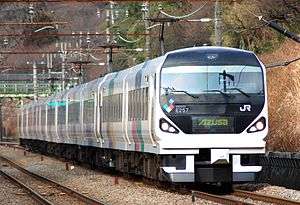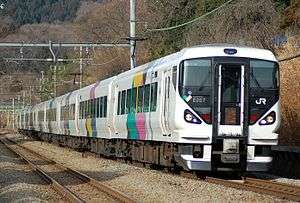E257 series
| E257 series | |
|---|---|
 An E257 series train on a Chuo Line Azusa service in January 2008 | |
| In service | 2001–Present |
| Manufacturer | Hitachi, Kinki Sharyo, Tokyu Car Corporation |
| Family name | A-train |
| Number built | 249 vehicles |
| Number in service | 249 vehicles |
| Formation | 2/5/9 cars per trainset |
| Operator(s) | JR East |
| Depot(s) | Matsumoto, Makuhari |
| Line(s) served | Chuo Main Line, Uchibo Line, Sotobo Line |
| Specifications | |
| Car length |
21,000 mm (68 ft 11 in) (end cars) 20,500 mm (67 ft 3 in) (intermediate cars) |
| Maximum speed | 130 km/h (80 mph) |
| Electric system(s) | 1,500 V DC overhead |
| Braking system(s) | Regenerative brake, electronically controlled pneumatic brakes, snow-resistant brake |
| Safety system(s) | ATS-SN, ATS-P |
| Track gauge | 1,067 mm (3 ft 6 in) |
The E257 series (E257系) is a DC electric multiple unit (EMU) train type operated in Japan by East Japan Railway Company (JR East) and built jointly by Hitachi, Kinki Sharyo, and Tokyu Car Corporation.
Variants
- E257-0 series: Chuo Main Line
- E257-500 series: Boso Express
Two variants exist: the original E257-0 series for use on Chuo Main Line Azusa and Kaiji limited-express services, and the E257-500 series for use on Uchibo Line, Sotobo Line, Sobu Main Line, Narita Line, and Kashima Line limited-express services.[1]
E257-0 series
This sub-series version was introduced on 1 December 2001, to replace the aging 183 and 189 series rolling stock on Chuo Main Line Azusa and Kaiji services. Based at Matsumoto depot, the fleet consists of sixteen 9-car sets (M101 to M116) with a full cab at the Matsumoto end and a gangwayed cab at the Tokyo end, and five 2-car "add-on" sets (M201 to M205) with a full cab at the Tokyo end and a shunting cab only at the Matsumoto end.
The type was the recipient of the 45th Blue Ribbon Award (2002) of the Japan Railfan Club.
Operations
- Chūō Main Line
- Azusa: Chiba - Tokyo - Shinjuku - Matsumoto - Minamiotari
- Kaiji: Tokyo - Shinjuku - Kōfu - Ryūō
- Chūō Liner: Tokyo - Shinjuku - Hachiōji - Takao
- Ōme Liner: Tokyo - Shinjuku - Tachikawa - Ōme
- Shinonoi Line
- Rapid: Matsumoto - Nagano
Matsumoto-based E257 series trains were also used on the Ohayo Liner Shinjuku and Home Liner Odawara commuter services running on the Tokaido Main Line until 14 March 2008.
From 2018, the E257 series trains are scheduled to be replaced by E353 series EMUs on Chuo Line Azusa and Kaiji limited express services and redeployed on Odoriko services.[2]
Formations
The nine-car sets (M101 to M116) are formed as follows.[3]
| Car No. | 3 | 4 | 5 | 6 | 7 | 8 | 9 | 10 | 11 |
|---|---|---|---|---|---|---|---|---|---|
| Designation | Tc | M | M' | M | T | Ts | M | M' | Tc' |
| Numbering | KuHa E257-100 | MoHa E257 | MoHa E256 | MoHa E257-1000 | SaHa E257 | SaRoHa E257 | MoHa E257-100 | MoHa E256-100 | KuHa E256 |
- Cars 4, 6, and 9 are each fitted with one PS37 single-arm pantograph.
The two-car sets (M201 to M205) are formed as follows.[3]
| Car No. | 1 | 2 |
|---|---|---|
| Designation | Tc | Mc |
| Numbering | KuHa E257 | KuMoHa E257 |
Car 2 is fitted with one PS37 single-arm pantograph.
 A 9-car set on a Kaiji service, with a gangwayed KuHa E257-100 car leading
A 9-car set on a Kaiji service, with a gangwayed KuHa E257-100 car leading- The gangway connection between a KuHa E257 car (left) and KuHa E256 car (right)
Interior
- Standard class seating (2+2)
- Green class seating (2+2)
 Mini-lounge area in car 9, previously a smoking area (until March 2007)
Mini-lounge area in car 9, previously a smoking area (until March 2007)
E257-500 series
The E257-500 sub-series version was delivered between July 2004 and October 2005, with the first sets entering service from 16 October 2004 on Uchibo Line Sazanami and Sotobo Line Wakashio limited-express services, replacing older 183 series rolling stock.[4] Based at Makuhari depot in Chiba Prefecture, the fleet consists of 19 5-car sets (NB01 to NB19).[3] Unlike the Chūō Line variant, these sets have gangways at both ends.
Formation
The five-car E257-500 series sets (NB01 to NB19) are formed as follows.[3]
| Car No. | 1 | 2 | 3 | 4 | 5 |
|---|---|---|---|---|---|
| Designation | Tc' | M | M' | M | Tc |
| Numbering | KuHa E256-500 | MoHa E257-1500 | MoHa E256-500 | MoHa E257-500 | KuHa E257-500 |
Cars 2 and 4 are each fitted with one PS37 single-arm pantograph.
- KuHa E256-500
- MoHa E257-1500
- MoHa E256-500
- MoHa E257-500
- KuHa E257-500
Services operated
- Uchibo Line
- Sazanami: Tokyo - Tateyama
- Sotobo Line
- Wakashio: Tokyo - Katsuura - Awa-Kamogawa
- Sobu Main Line
- Yokosuka Line
- Ohayo Liner Zushi: Zushi - Tokyo
- Home Liner Zushi: Tokyo - Zushi
Interior
The E257-500 series sets are monoclass, with standard-class accommodation only.
References
- ↑ Jēāru zensharyō handobukku: Rail Magazine 2009 JR全車輌ハンドブック2009 [JR Rolling Stock Handbook 2009]. Japan: Neko Publishing. 2009. pp. 149–151. ISBN 978-4-7770-0836-0.
- ↑ 来年3月に現行車両「E351系」引退 スーパーあずさ、新型に [E351 series to be retired by next spring with new trains for "Super Azusa" services]. Sankei Photo (in Japanese). Japan: The Sankei Shimbun & Sankei Digital. 29 October 2017. Archived from the original on 22 November 2017. Retrieved 22 November 2017.
- 1 2 3 4 JR電車編成表 2011夏 [JR EMU Formations - Summer 2011]. Japan: JRR. May 2010. ISBN 978-4-330-21211-1.
- ↑ E257系500代が〈さざなみ〉〈わかしお〉で運転開始 [E257-500 series enter service on "Sazanami" and "Wakashio"]. Railway Journal. 39 (459): 102. January 2005.
External links
| Wikimedia Commons has media related to E257 series. |
- E257, Tokyu Car Corp
- E257-500, Kinki Sharyo
- E257, Hitachi Rail
- JR E257 Azusa/Kaiji (in Japanese)
- JR E257-500 Wakashio/Sazanami (in Japanese)